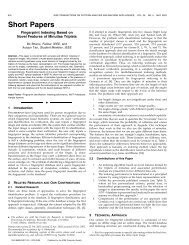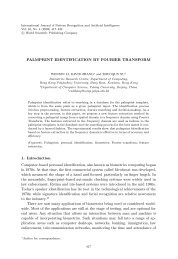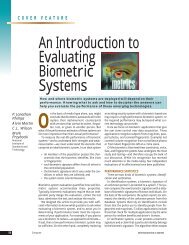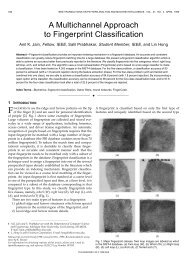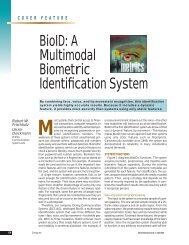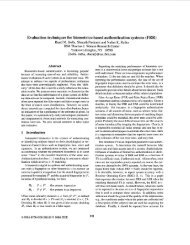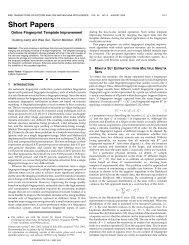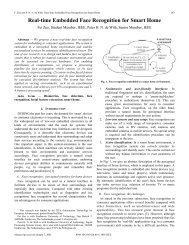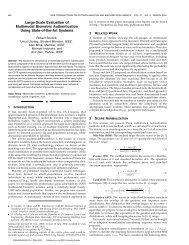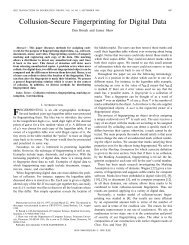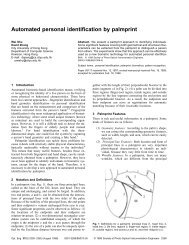Improved fingercode for filterbank-based fingerprint matching ...
Improved fingercode for filterbank-based fingerprint matching ...
Improved fingercode for filterbank-based fingerprint matching ...
Create successful ePaper yourself
Turn your PDF publications into a flip-book with our unique Google optimized e-Paper software.
5. EXPERIMENTS<br />
Experiments are conducted on a standard <strong>fingerprint</strong><br />
database NIST-4, which contains a set of 2000 <strong>fingerprint</strong><br />
image pairs (512x512, 256 gray levels, 500 dpi). Each<br />
<strong>fingerprint</strong> pair has two different rolled impressions of the<br />
same finger. We remove some <strong>fingerprint</strong>s if their<br />
reference points are too close to the edge of the image.<br />
To test the per<strong>for</strong>mance of the oriented Fingercode,<br />
we first implement a <strong>filterbank</strong>-<strong>based</strong> <strong>fingerprint</strong> <strong>matching</strong><br />
system using the original approach [5]. Here, we replace<br />
the reference point location algorithm with the new<br />
algorithm discussed in Section 3. The dataset is then<br />
processed using the implemented system.<br />
We then replace the FingerCode generation module<br />
with the new algorithm to compute the oriented<br />
FingerCode. The same dataset is again processed. Each<br />
test <strong>fingerprint</strong> image is matched with all the other<br />
<strong>fingerprint</strong>s in the database. If the Euclidean distance<br />
between two Fingercodes is helow a threshold, we make<br />
the decision that “the two <strong>fingerprint</strong> images are<br />
matched”; otherwise, we say, “the two <strong>fingerprint</strong> images<br />
come from different fingers”. The <strong>matching</strong> is labeled<br />
correct if the matched pair is from the same finger and<br />
incorrect, otherwise. The genuine acceptance rate (GAR)<br />
and the false acceptance rate (FAR) corresponding to a<br />
distance threshold are computed according to these<br />
labeled <strong>matching</strong> results. The overall <strong>matching</strong><br />
per<strong>for</strong>mance can be measured by a receiver operating<br />
characteristic (ROC) curve, which plots GAR against<br />
FAR at different operating points (distance thresholds).<br />
Each point on the curve corresponds to a special distance<br />
threshold. In the experiments, we use the Gabor filters<br />
with various f and a,., S,.. Figure 5 illustrates the<br />
per<strong>for</strong>mance improvement of the new approach. The<br />
dashed line represents the per<strong>for</strong>mance of the original<br />
approach [5], while the solid line shows the per<strong>for</strong>mance<br />
of the new approach. From the results, we can see that the<br />
new approach outper<strong>for</strong>ms the original approach over a<br />
wide range of FAR values, especially at low FAR values.<br />
6. CONCLUSION<br />
In this paper, we have presented an improved method <strong>for</strong><br />
filterhank-<strong>based</strong> <strong>fingerprint</strong> <strong>matching</strong>, which utilize both<br />
the AAD features and the direction features available in<br />
the <strong>fingerprint</strong>s. Experimental results obtained from a<br />
large <strong>fingerprint</strong> database (NIST-4) show that the addition<br />
of the direction features leads to a substantial<br />
improvement in the overall <strong>matching</strong> per<strong>for</strong>mance.<br />
Moreover, the proposed reference point location method<br />
is robust and rotation-invariant <strong>for</strong> <strong>fingerprint</strong> images.<br />
7. ACKNOWLEDGMENT<br />
The work described in this paper was fully supported by a<br />
grant from the Research Grants Council of the Hong<br />
Kong SAR (Project no. CUHK 4190101E).<br />
Figure 5. ROC curves comparing the per<strong>for</strong>mance of the new<br />
Fingeeode with the original Fingeeode on the NIST-4<br />
database.<br />
8. REFERENCES<br />
[I] A. K. Hrechak and I. A. Mchugh, “Automated <strong>fingerprint</strong><br />
recognition using stmcturai <strong>matching</strong>,” Parrern<br />
Recognition, vol. 23, no. 8, pp. 893-904, 1990.<br />
[2] A.K. lain, L. Hong, S. Pankanti, and R. Bolle, ” An<br />
identity authcntication system using <strong>fingerprint</strong>s”, Proc.<br />
E€€, Vol. 85,No. 9, pp. 1365-1388, 1997.<br />
[3] A. K. lain, S. Prabhakar, and L. Hong, “ A multichannel<br />
approach to <strong>fingerprint</strong> classification,” IEEE Trans.<br />
Pattern Anal Machine /nk?l/., vol. 21, no. 4, pp. 348-359,<br />
1999.<br />
14) A. K. lain, S. Prabhakar, L. Hong, and S, Pankanti,<br />
“Fingeeode: a <strong>filterbank</strong> <strong>for</strong> <strong>fingerprint</strong> representation and<br />
<strong>matching</strong>,” Proc. IEEE Computer Society Con/ Compurer<br />
Vision and Partern Recognirion(CVPR), vol. 2, pp. 187-<br />
193, 1999.<br />
[SI A. K. lain, S. Prabhakar, L. Hong, and S. Pankanti,<br />
“Filterbank-<strong>based</strong> <strong>fingerprint</strong> <strong>matching</strong>,” IEEE Trans.<br />
Image Processing., vol. 9, no. 5, pp. 846-859, 2000.<br />
161 D. Maio and D. Maltoni, “Direct gray-scale minutiae<br />
detection in <strong>fingerprint</strong>s,” IEEE Tram. Parrern Anol.<br />
Machine InreN., vol. 19 no. I , pp. 27-40, 1997.<br />
[7] N. Ratha, S. Chen, K. Kam, and A.K. lain, ” A real-time<br />
<strong>matching</strong> system <strong>for</strong> large <strong>fingerprint</strong> databases”, IEEE<br />
Tram Parrern Anal. Machine Iniell., vol. 18, no. 8, pp.<br />
799-813. 1996<br />
II - 898



